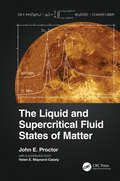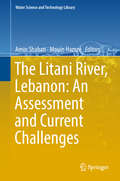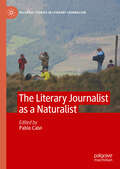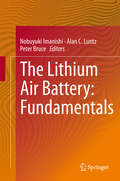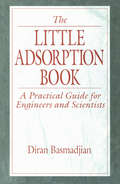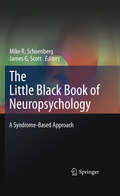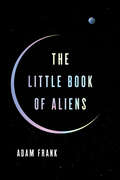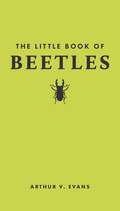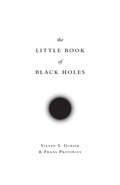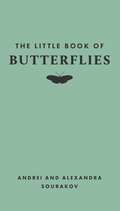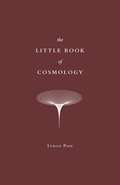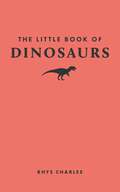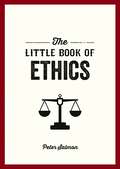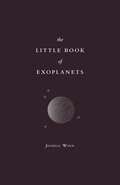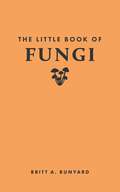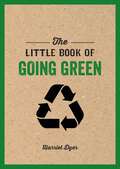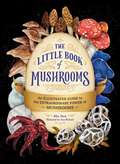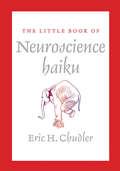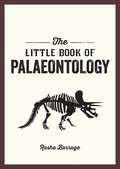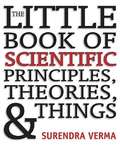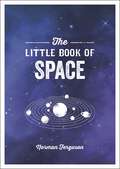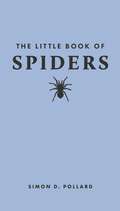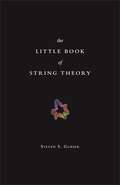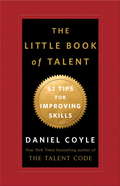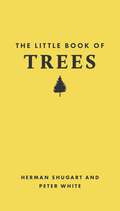- Table View
- List View
The Liquid and Supercritical Fluid States of Matter
by John E. ProctorThis book addresses graduate students and researchers wishing to better understand the liquid and supercritical fluid states of matter, presenting a single cohesive treatment of the liquid and supercritical fluid states using the gas-like and solid-like approaches. Bringing this information together into one comprehensive text, this book outlines how our understanding of the liquid and supercritical fluid states is applied and explores the use of supercritical fluids in daily life and in research, for example in power generation, and their existence in planetary interiors. Presents a single coherent treatment of the key knowledge about the liquid and supercritical fluid states Provides comprehensive survey of key fluid properties from the latest experiments and applies our theoretical knowledge to understand the behaviour of these real fluids Explores the consequences of recent advances in the field on our understanding in industry, nature, and in interdisciplinary research, including planetary science
The Litani River, Lebanon: An Assessment and Current Challenges (Water Science and Technology Library #85)
by Amin Shaban Mouin HamzéThis book presents a collection of chapters covering research on the Litani River Basin. The Litani River Basin occupies about a quarter of Lebanon's surface area, and it has recently been subject to severe geo-environmental conditions such as water contamination and decreased discharge. This motivated the Lebanese government to take action and start working on the remediation of the river. These actions are also supported by international organizations including the World Bank.
The Literary Journalist as a Naturalist (Palgrave Studies in Literary Journalism)
by Pablo CalviThis book is a scholarly anthology that proposes a deep discussion about the multiple ways in which narrative journalism has portrayed nature, human interactions with nature, the global actions and the consequences of activities that have either attempted to explore it, exploit it, harness it, dominate it, and protect it. This essay collection offers an academic framework for literary journalistic narratives about nature and includes the study of long form journalism originated in different corners of the world, all exploring human-non human-nature interactions in all their power, finitude, peril and urgency.
The Lithium Air Battery
by Nobuyuki Imanishi Alan C. Luntz Peter BruceLithium air rechargeable batteries are the best candidate for a power source for electric vehicles, because of their high specific energy density. In this book, the history, scientific background, status and prospects of the lithium air system are introduced by specialists in the field. This book will contain the basics, current statuses, and prospects for new technologies. This book is ideal for those interested in electrochemistry, energy storage, and materials science.
The Little Adsorption Book: A Practical Guide for Engineers and Scientists
by Diran BasmadjianThis unique approach to the basic concepts of adsorption is written for students, engineers, scientists, and others who need a clear presentation of adsorption processes. Unlike other texts on this subject, which are written for the specialist and rely heavily on advanced mathematics, this unique book helps you solve everyday problems in applications of adsorption, without complex mathematics or computers.The author, a recognized expert in the field, gives you a quick introduction to the underlying physics of absorption and explains how to apply adsorption to solve analytical and design problems. Rich with practical examples and enhanced by illustrations that support the text, this refreshingly straightforward presentation helps you cut through the complexities of adsorption to find fast answers to pressing real-world questions.
The Little Black Book of Neuropsychology
by Mike R. Schoenberg James G. ScottFrom translating the patient's medical records and test results to providing recommendations, the neuropsychological evaluation incorporates the science and practice of neuropsychology, neurology, and psychological sciences. The Little Black Book of Neuropsychology brings the practice and study of neuropsychology into concise step-by-step focus--without skimping on scientific quality. This one-of-a-kind assessment reference complements standard textbooks by outlining signs, symptoms, and complaints according to neuropsychological domain (such as memory, language, or executive function), with descriptions of possible deficits involved, inpatient and outpatient assessment methods, and possible etiologies. Additional chapters offer a more traditional approach to evaluation, discussing specific neurological disorders and diseases in terms of their clinical features, neuroanatomical correlates, and assessment and treatment considerations. Chapters in psychometrics provide for initial understanding of brain-behavior interpretation as well as more advanced principals for neuropsychology practice including new diagnostic concepts and analysis of change in performance over time. For the trainee, beginning clinician or seasoned expert, this user-friendly presentation incorporating 'quick reference guides' throughout which will add to the practice armentarium of beginning and seasoned clinicians alike. Key features of The Black Book of Neuropsychology: Concise framework for understanding the neuropsychological referral. Symptoms/syndromes presented in a handy outline format, with dozens of charts and tables. Review of basic neurobehavioral examination procedure. Attention to professional issues, including advances in psychometrics and diagnoses, including tables for reliable change for many commonly used tests. Special "Writing Reports like You Mean It" section and guidelines for answering referral questions.Includes appendices of practical information, including neuropsychological formulary. The Little Black Book of Neuropsychology is an indispensable resource for the range of practitioners and scientists interested in brain-behavior relationships. Particular emphasis is provided for trainees in neuropsychology and neuropsychologists. However, the easy to use format and concise presentation is likely to be of particular value to interns, residents, and fellows studying neurology, neurological surgery, psychiatry, and nurses. Finally, teachers of neuropsychological and neurological assessment may also find this book useful as a classroom text. "There is no other book in the field that covers the scope of material that is inside this comprehensive text. The work might be best summed up as being a clinical neuropsychology postdoctoral residency in a book, with the most up to date information available, so that it is also an indispensible book for practicing neuropsychologists in addition to students and residents...There is really no book like this available today. It skillfully brings together the most important foundationsof clinical neuropsychology with the 'nuts and bolts' of every facet of assessment. It also reminds the more weathered neuropsychologists among us of the essential value of neuropsychological assessment...the impact of the disease on the patient's cognitive functioning and behavior may only be objectively quantified through a neuropsychological assessment." Arch Clin Neuropsychol (2011) first published online June 13, 2011 Read the full review acn.oxfordjournals.org
The Little Book of Aliens
by Adam Frank“With wit and brio, Frank separates current nonsense about aliens from the serious and fascinating search for extraterrestrial life.” —Carlo Rovelli, New York Times bestselling author of Seven Brief Lessons on PhysicsFrom astrophysicist Adam Frank, a little book on the biggest questions in our search for extraterrestrial life, questions we stand ready to answer.Everyone is curious about life in the Universe, UFOs and whether ET is out there. Over the course of his thirty-year career as an astrophysicist, Adam Frank has consistently been asked about the possibility of intelligent life in the universe. Are aliens real? Where are they? Why haven’t we found them? What happens if we do?We’ve long been led to believe that astronomers spend every night searching the sky for extraterrestrials, but the truth is we have barely started looking. Not until now have we even known where to look or how. In The Little Book of Aliens, Frank, a leading researcher in the field, takes us on a journey to all that we know about the possibility of life outside planet Earth and shows us the cutting-edge science that has brought us to this unique moment in human history: the one where we go find out for ourselves.In this small book with big stakes, Frank gives us a rundown of everything we need to know, from the scientific origins of the search for intelligent life, the Fermi Paradox, the Kardashev Scale, the James Webb Telescope, as well as UFOs and their conspiracy theories. Drawing from his own work and that of other scientists studying the possibility of alien life, he brings together the latest scientific thinking, data, ideas, and discoveries to equip us with the critical facts as we stand at what may be the last moment in human history where we still believe we are all alone. This book is about everything we do—and do not—know about life, intelligent or otherwise beyond Earth. In language that is engaging, entertaining and fun, The Little Book of Aliens provides a comprehensive first look at how close we are to finding out if others actually exist—and if they do, what they might be like.Humankind is on the precipice of finding its neighbors. What comes next? No person is better suited to answer that question—and lead the search—than Adam Frank.
The Little Book of Beetles (Little Books of Nature #2)
by Arthur V. EvansA charming, richly illustrated, pocket-size exploration of the world&’s beetlesPacked with surprising facts, this delightful and gorgeously designed book will beguile any nature lover. Expertly written and beautifully illustrated throughout with color photographs and original color artwork, The Little Book of Beetles is an accessible and enjoyable mini reference about the world&’s beetles, with examples drawn from across the globe. It fits an astonishing amount of information in a small package, covering a wide range of topics—from anatomy, diversity, and reproduction to habitat and conservation. It also includes curious facts and a section on beetles in myths, folklore, and modern culture from around the world. The result is an irresistible guide to the amazing lives of beetles.A beautifully designed pocket-size book with a foil-stamped cloth coverFeatures some 140 color illustrations and photosMakes a perfect gift
The Little Book of Black Holes
by Steven S. Gubser Frans PretoriusDive into a mind-bending exploration of the physics of black holesBlack holes, predicted by Albert Einstein’s general theory of relativity more than a century ago, have long intrigued scientists and the public with their bizarre and fantastical properties. Although Einstein understood that black holes were mathematical solutions to his equations, he never accepted their physical reality—a viewpoint many shared. This all changed in the 1960s and 1970s, when a deeper conceptual understanding of black holes developed just as new observations revealed the existence of quasars and X-ray binary star systems, whose mysterious properties could be explained by the presence of black holes. Black holes have since been the subject of intense research—and the physics governing how they behave and affect their surroundings is stranger and more mind-bending than any fiction.After introducing the basics of the special and general theories of relativity, this book describes black holes both as astrophysical objects and theoretical “laboratories” in which physicists can test their understanding of gravitational, quantum, and thermal physics. From Schwarzschild black holes to rotating and colliding black holes, and from gravitational radiation to Hawking radiation and information loss, Steven Gubser and Frans Pretorius use creative thought experiments and analogies to explain their subject accessibly. They also describe the decades-long quest to observe the universe in gravitational waves, which recently resulted in the LIGO observatories’ detection of the distinctive gravitational wave “chirp” of two colliding black holes—the first direct observation of black holes’ existence.The Little Book of Black Holes takes readers deep into the mysterious heart of the subject, offering rare clarity of insight into the physics that makes black holes simple yet destructive manifestations of geometric destiny.
The Little Book of Butterflies (Little Books of Nature #1)
by Andrei Sourakov Alexandra A. SourakovA charming, richly illustrated, pocket-size exploration of the world&’s butterfliesPacked with surprising facts, this delightful and gorgeously designed book will beguile any nature lover. Expertly written and beautifully illustrated throughout with color photographs and original color artwork, The Little Book of Butterflies is an accessible and enjoyable mini reference about the world&’s butterflies, with examples drawn from across the globe. It fits an astonishing amount of information in a small package, covering a wide range of topics—from anatomy, diversity, and reproduction to habitat and conservation. It also includes curious facts and a section on butterflies in myths, folklore, and modern culture from around the world. The result is an irresistible guide to the amazing lives of butterflies.A beautifully designed pocket-size book with a foil-stamped cloth coverFeatures some 140 color illustrations and photosMakes a perfect gift
The Little Book of Cosmology
by Lyman PageThe cutting-edge science that is taking the measure of the universeThe Little Book of Cosmology provides a breathtaking look at our universe on the grandest scales imaginable. Written by one of the world's leading experimental cosmologists, this short but deeply insightful book describes what scientists are revealing through precise measurements of the faint thermal afterglow of the Big Bang—known as the cosmic microwave background, or CMB—and how their findings are transforming our view of the cosmos.Blending the latest findings in cosmology with essential concepts from physics, Lyman Page first helps readers to grasp the sheer enormity of the universe, explaining how to understand the history of its formation and evolution in space and time. Then he sheds light on how spatial variations in the CMB formed, how they reveal the age, size, and geometry of the universe, and how they offer a blueprint for the formation of cosmic structure.Not only does Page explain current observations and measurements, he describes how they can be woven together into a unified picture to form the Standard Model of Cosmology. Yet much remains unknown, and this incisive book also describes the search for ever deeper knowledge at the field's frontiers—from quests to understand the nature of neutrinos and dark energy to investigations into the physics of the very early universe.
The Little Book of Dinosaurs (Little Books of Nature)
by Rhys CharlesA charming, richly illustrated, pocket-size exploration of dinosaursPacked with surprising facts, this delightful and gorgeously designed book will beguile any dinosaur lover. Expertly written and beautifully illustrated throughout with color photographs and original color artwork, The Little Book of Dinosaurs is an accessible and enjoyable mini-reference. It fits an astonishing amount of information in a small package, covering a wide range of topics—from dinosaur diversity and social behaviors to their extinction and rediscovery. It also includes curious facts and a section on dinosaurs in myths, folklore, and popular culture from around the globe. The result is an irresistible guide to the amazing world of dinosaurs.A beautifully designed pocket-size book with a foil-stamped cloth coverFeatures some 140 color illustrations and photosMakes a perfect gift
The Little Book of Ethics: An Introduction to the Key Principles and Theories You Need to Know
by Peter SalmonThis accessible and thought-provoking guide will take you on a captivating exploration of the fundamental questions that form our decisions and actions, asking, what is the right thing to do in a certain set of circumstances? What can we base our decision on? Is there always a correct decision, or is it always a bit unclear?
The Little Book of Exoplanets
by Joshua N. WinnA concise and accessible introduction to exoplanets that explains the cutting-edge science behind recent discoveriesFor centuries, people have speculated about the possibility of planets orbiting distant stars, but only since the 1990s has technology allowed astronomers to detect them. At this point, more than five thousand such exoplanets have been identified, with the pace of discovery accelerating after the launch of NASA’s Transiting Exoplanet Survey Satellite and the Webb Space Telescope. In The Little Book of Exoplanets, Princeton astrophysicist Joshua Winn offers a brief and engaging introduction to the search for exoplanets and the cutting-edge science behind recent findings. In doing so, he chronicles the dawn of a new age of discovery—one that has rapidly transformed astronomy and our broader understanding of the universe.Scientists now know that many Sun-like stars host their own systems of planets, some of which may resemble our solar system and include planets similar to the Earth. But, Winn tells us, the most remarkable discoveries so far have been of planets with unexpected and decidedly un-Earth-like properties, which have upended what we thought we knew about the origins of planetary systems. Winn provides an inside view of the sophisticated detective work astronomers perform as they find and study exoplanets and describes the surprising—sometimes downright bizarre—planets and systems they have found. He explains how these discoveries are revolutionizing astronomy, and he explores the current status and possible future of the search for another Earth. Finally, drawing on his own and other scientists’ work, he considers how the discovery of exoplanets and their faraway solar systems changes our perspectives on the universe and our place in it.
The Little Book of Fungi (Little Books of Nature)
by Britt A. BunyardA charming, richly illustrated, pocket-size exploration of the world&’s fungiPacked with surprising facts, this delightful and gorgeously designed book will beguile any nature lover. Expertly written and beautifully illustrated throughout with color photographs and original color artwork, The Little Book of Fungi is an accessible and enjoyable mini-reference about the world&’s fungi, with examples drawn from across the globe. It fits an astonishing amount of information in a small package, covering a wide range of topics—from morphology, diversity, and reproduction to habitat and conservation. It also includes curious facts and a section on fungi in myths, folklore, and modern culture from around the world. The result is an irresistible guide to the amazing lives of fungi.A beautifully designed pocket-size book with a foil-stamped cloth coverFeatures some 140 color illustrations and photosMakes a perfect gift
The Little Book of Going Green: An Introduction to Climate Change and How We Can Reduce Our Carbon Footprint (The\little Book Of Ser.)
by Harriet DyerThe Little Book of Going Green aims to shed light on the ways humans are harming the environment, from pollution and deforestation to industrial production and farming methods. Filled with facts, theories and tips on how we can do our bit for the planet, this is your one-stop guide to making every aspect of your life earth-friendly.
The Little Book of Mushrooms: An Illustrated Guide to the Extraordinary Power of Mushrooms
by Alex DorrA beautifully illustrated guide to 75 of the most unique and fascinating mushrooms in the world, including interesting insight into their history, uses, and etymologies.From sweet little toadstools to giant puffballs, mushrooms come in all shapes and sizes. With over 10,000 mushrooms in the world, some are cute and colorful, while others may look super adorable but are actually deadly. No matter the kind, it&’s time to celebrate all types of mushrooms with The Little Book of Mushrooms. This book is a collection of everything you need to know about 75 of the world&’s most unique mushrooms. With information on their etymology, geographic location, characteristics, and culinary or healing powers, this book is the perfect companion for amateur mushroom hunters, cottage-core fans, or anyone just looking for a beautifully illustrated book on some of the most incredible fungi around the world.
The Little Book of Neuroscience Haiku
by Eric ChudlerFun, informative poetry about the brain. Elephant on brain "You have a lot on your mind" Neurologist says. The brain has fascinated philosophers and scientists for centuries. And why not? It is perhaps the most mysterious thing in the universe. Yet it's probably safe to say that The Little Book of Neuroscience Haiku approaches the brain in a way that no one has before. Neuroscientist Eric H. Chudler has created a whimsical yet educational book of haiku about the brain, each poem conforming to the strict definition of the Japanese verse form: three lines containing five syllables, seven syllables, and five syllables. Organized in three parts, one part discusses places (areas of the brain); one takes up things (such as brain scans); and one is about people (such as the researchers who have helped us learn about this elusive organ). Extensive notes complete the book, educating readers in an amusing, poetic, and at times moving fashion. This book will be sure to delight science readers.
The Little Book of Palaeontology: The Pocket Guide to Our Fossilized Past
by Rasha BarrageIf you want to know your ichthyosaur from your iguanodon, and your belemnites from your brachiopods, strap in for this whirlwind tour of the highlights of palaeontology Life as we know it now has a long history, buried beneath the ground. Palaeontology is the science of fossilized animals and plants, using discoveries of ancient lifeforms to uncover secrets of the past. From giant dinosaurs, to ammonites, to the first ever humans, explore the greatest findings in palaeontology in this pocket-sized introduction. The Little Book of Palaeontology includes:- The key palaeontological discoveries over the past 400 years, including the dinosaur found complete with intricate scales, and the largest fossil ever uncovered- Profiles of influential palaeontologists such as Jack Horner, Dong Zhiming and Mary Anning- What we have learnt about the lives of ancient creatures and how they became extinct- The big questions about the prehistoric world that palaeontologists are trying to answer todayThis illuminating little book will introduce you to the key thinkers, themes and theories you need to know to understand how life evolved. Look through this window to the past and learn about our prehistoric ancestors and the creatures of a bygone age.
The Little Book of Scientific Principles, Theories, and Things
by Surendra VermaWhat is Pythagoras' Theorem? Who developed the World Wide Web? What is the difference between circadian rhythms and the popular concept of biorhythms? Find out the answers here, where serious science is presented simply, clearly, and chronologically for the layperson. This book explains 175 of the most important laws, principles, equations, and theories that form the foundation of the field as we know it. All the great names are featured, including Galileo, Newton, Darwin, and Einstein, as well as more recent contributors such as Rachel Carson, James Lovelock, and Stephen Hawking.
The Little Book of Space: An Introduction to the Solar System and Beyond
by Norman FergusonSpace is spectacularThis short, informative and engaging guide to the wonders of the universe will fascinate and inspire readers of all agesThere’s never been a more exciting time to learn about space. As new rockets are launched and fresh discoveries are made, humanity’s urge to explore and understand what’s going on out there keeps evolving and expanding.But you don’t need to have Einstein-level training to grasp the science and ponder the big questions. This little book covers everything from the Big Bang and the formation of the planets in our solar system, and how to spot them in the night sky, to a timeline of firsts and major events, including the Apollo missions, Elon Musk’s SpaceX programme and Tim Peake’s Principia mission.Packed with awe-inspiring facts and profiles of key figures, it will take you on an out-of-this-world adventure to the stars and back.Among the many fascinating questions the book will answer are these:How big is the universe and how was it formed?How many meteorites crash into Earth every day?Could humans one day live on Mars?Are we alone in the universe?
The Little Book of Spiders (Little Books of Nature #3)
by Simon PollardA charming, richly illustrated, pocket-size exploration of the world&’s spidersPacked with surprising facts, this delightful and gorgeously designed book will beguile any nature lover. Expertly written and beautifully illustrated throughout with color photographs and original color artwork, The Little Book of Spiders is an accessible and enjoyable mini reference about the world&’s spiders, with examples drawn from across the globe. It fits an astonishing amount of information in a small package, covering a wide range of topics—from anatomy, diversity, and reproduction to habitat and conservation. It also includes curious facts and a section on spiders in myths, folklore, and modern culture from around the world. The result is an irresistible guide to the amazing lives of spiders.A beautifully designed pocket-size book with a foil-stamped cloth coverFeatures some 140 color illustrations and photosMakes a perfect gift
The Little Book of String Theory (Science Essentials #11)
by Steven S. GubserThe essential beginner's guide to string theoryThe Little Book of String Theory offers a short, accessible, and entertaining introduction to one of the most talked-about areas of physics today. String theory has been called the "theory of everything." It seeks to describe all the fundamental forces of nature. It encompasses gravity and quantum mechanics in one unifying theory. But it is unproven and fraught with controversy. After reading this book, you'll be able to draw your own conclusions about string theory.Steve Gubser begins by explaining Einstein's famous equation E = mc2, quantum mechanics, and black holes. He then gives readers a crash course in string theory and the core ideas behind it. In plain English and with a minimum of mathematics, Gubser covers strings, branes, string dualities, extra dimensions, curved spacetime, quantum fluctuations, symmetry, and supersymmetry. He describes efforts to link string theory to experimental physics and uses analogies that nonscientists can understand. How does Chopin's Fantasie-Impromptu relate to quantum mechanics? What would it be like to fall into a black hole? Why is dancing a waltz similar to contemplating a string duality? Find out in the pages of this book.The Little Book of String Theory is the essential, most up-to-date beginner's guide to this elegant, multidimensional field of physics.
The Little Book of Talent: 52 Tips for Improving Your Skills
by Daniel CoyleThe Little Book of Talent is a manual for building a faster brain and a better you. It is an easy-to-use handbook of scientifically proven, field-tested methods to improve skills--your skills, your kids' skills, your organization's skills--in sports, music, art, math, and business. The product of five years of reporting from the world's greatest talent hotbeds and interviews with successful master coaches, it distills the daunting complexity of skill development into 52 clear, concise directives. Whether you're age 10 or 100, whether you're on the sports field or the stage, in the classroom or the corner office, this is an essential guide for anyone who ever asked, "How do I get better?""The Little Book of Talent should be given to every graduate at commencement, every new parent in a delivery room, every executive on the first day of work. It is a guidebook--beautiful in its simplicity and backed by hard science--for nurturing excellence."--Charles Duhigg, bestselling author of The Power of Habit "It's so juvenile to throw around hyperbolic terms such as 'life-changing,' but there's no other way to describe The Little Book of Talent. I was avidly trying new things within the first half hour of reading it and haven't stopped since. Brilliant. And yes: life-changing."--Tom Peters, co-author of In Search of ExcellenceFrom the Hardcover edition.
The Little Book of Trees (Little Books of Nature #4)
by Peter White Herman ShugartA charming, richly illustrated, pocket-size exploration of the world&’s treesPacked with surprising facts, this delightful and gorgeously designed book will beguile any nature lover. Expertly written and beautifully illustrated throughout with color photographs and original color artwork, The Little Book of Trees is an accessible and enjoyable mini reference about the world&’s trees, with examples drawn from across the globe. It fits an astonishing amount of information in a small package, covering a wide range of topics—from tree anatomy, diversity, and architecture to habitat and conservation. It also includes curious facts and a section on trees in myths, folklore, and modern culture from around the world. The result is an irresistible guide to the amazing lives of trees.A beautifully designed pocket-size book with a foil-stamped cloth coverFeatures some 140 color illustrations and photosMakes a perfect gift
